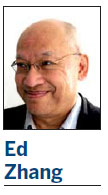New indexes show economic health
Updated: 2016-05-06 06:56
By Ed Zhang(China Daily Europe)
|
|||||||||
Watching traffic jams and nighttime deliveries can be more useful than old measuring sticks like electricity consumption
As the government keeps giving out not quite consistent data about an economy of nearly 1.4 billion people, and distant observers air sometimes sharply contrasting opinions on what "real problems" are lurking behind the government data, how can a resident businessperson form his or her own view about the real situation?
Where does the person look for the real indicators of what theorists may call a hard landing or "stabilizing"? And how can the person decide if the stability on the surface can last, and if it can, how long?
In the past few years, different people have taught us their own sets of indexes about the economy. There were the so-called Keqiang indexes, which Premier Li Keqiang used to fathom the trends underneath the regular reports by the National Bureau of Statistics. One index was about energy (electricity) use.

But those indexes are now no longer quite as useful as when the main part of the economy was made up of old-economy activities, manufacturing businesses based on a standard level of material and energy use. The part of the economy is losing its weight, as the daily reports about China's excess industrial capacity indicate, and energy use can no longer be used as a yardstick to measure general prosperity.
Economists have compiled other, more consumer-oriented indexes to reflect the relative change of balance between a shrinking manufacturing sector and a growing service sector, such as indexes on tourism like air travel, and the revenue of the UnionPay card, the national credit/debit card monopoly, which is an index on overall consumer spending.
Nonetheless, on the street, there are also quite reliable natural indexes of how the economy has been faring in general, and how a local economy (in an individual city) has done in reflecting the nation's changing trends.
First - and it's very important for first-time visitors to a city - is the downtown traffic. In Beijing, if there still is congestion in the so-called central business district (middle sections of the second, third, and fourth east ring roads) during the lunch hour and early afternoon, and it doesn't disappear until around 10:30 pm, then you can tell business is picking up.
This is what one can see in that area nowadays, but not in the beginning of the year (until a few weeks after Chinese New Year in early February). The exceptions are Sundays and perhaps Mondays. Mondays' business can always be uncertain, as the local cab drivers say.
As for traffic, it is no longer as useful as in the past to count construction trucks on the main roads in the middle of the night. There definitely are fewer than a few years ago in Beijing.
But one can still see a lot in a visit to market streets selling products for interior decoration and renovation. Beijing's Shi Li He is lined with showrooms with flooring and toilet fixtures. By checking the size of the crowd and the change in product styles, one gets some idea about the housing market.
Housing is an important part of the real economy of every city, although Chinese officials are reluctant to acknowledge it (because for them it's still something hard to manage).
And for the moneyed people, housing units in large cities (first- and second-tier cities) are still a much easier investment market than securities markets dominated by state-owned players and amateurish regulators.
By contrast, a visit to department stores never reveals much. It's a business that is quickly dying thanks to the increasing popularity of all kinds of e-retail. Instead, in streets near university campuses, it may be interesting to check how much delivery business is going on around midnight - when students get hungry and tired from their homework or (more likely) their online entertainment programs.
For a long-time resident, it is very useful to watch the neighborhood retail and restaurant businesses - especially in a relatively busy area. Notice whether any roadside spaces remain vacant, whether the variety in their offerings are growing or whether the restaurants are no longer dominated by the local cuisine (an indicator of a city's openness to migrant workers and foreigners), and whether their interior conditions improve over time, however small they are.
At the same time, if one can read some Chinese, the information on a mobile device is a good thing to watch, too - such as by comparing the news feed (about business or other things) from mobile media with the content floating in WeChat friends' circles. If friends are always leading the media, instead of the other way round, in generating hot topics and attracting public interest, then you know society is full of vigor and creativity and is ready for something new.
The author is editor-at-large of China Daily. Contact the writer at edzhang@chinadaily.com.cn
Today's Top News
Inspectors to cover all of military
Britons embrace 'Super Thursday' elections
Campaign spreads Chinese cooking in the UK
Trump to aim all guns at Hillary Clinton
Labour set to take London after bitter campaign
Labour candidate favourite for London mayor
Fossil footprints bring dinosaurs to life
Buffett optimistic on China's economic transition
Hot Topics
Lunar probe , China growth forecasts, Emission rules get tougher, China seen through 'colored lens', International board,
Editor's Picks

|

|

|

|

|

|







